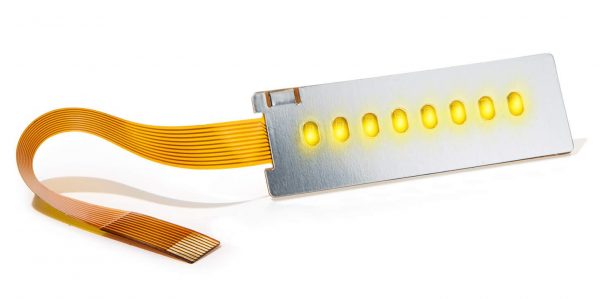About Copper Flex Circuits
Unlike screen-printed silver, copper flex circuits are manufactured by laminating copper to an underlying substrate, and then etching that substrate in a way that leaves specific conductive traces. This is a more rigorous process than screen-printing, but it results in a more flexible, more durable, and more precise circuit. In addition, the base material of copper flex circuits is polyimide – a very high temperature substrate that allows you to surface mount components such as LEDs, resistors, and light sensors.
Advantages
- Compact Design
- Better Electrical Tolerances (less resistance)
- Visual and Audible Feedback
- Automation Opportunities
Disadvantages
- More Advanced Design
- Higher Manufacturing Demands
- Higher Costs
- Copper Flex Circuits are Typically Sourced “Off-Shore”
Base Material
The typical base material for a copper flex circuit is .001″, .002″, .003″ and .005″ polyimide or polyester. Unlike silver flex (which uses a conductive epoxy), these materials will hold up to the robust solder required to attach components.
Copper Flex
The copper can be either .50z, 1.00z, or 2.00z RA or ED copper.
One of the key advantages of copper flex circuitry is the precision it gives engineers when managing the size and space (or pitch) between the conductive traces. With silver, the minimum pitch is 1mm. Meanwhile, the minimum trace width for copper flex is .004″ with a pitch of .004″. This becomes critically important in compact devices where switch size must be as compressed as possible. It is also important when a small connection must be made on the mating PCBA, since surface area is always at a premium on small “mother boards”.
Another advantage of copper flex is its ability to withstand bending and creasing. This allows engineers to design extremely compact switch assemblies, leveraging flexible circuits and complex, intricate paths to solve what would otherwise be insurmountable interconnection challenges. The result is reduced weight, reduced size, and reduced overall thickness.
Embedded Components
 To enhance user feedback, membrane switches are often designed with (but are not limited to) embedded LEDs, light sensors, and resistors. These surface-mounted components can be adhered to the circuit layer with conductive epoxy and encapsulated with a UV cured polyurethane.
To enhance user feedback, membrane switches are often designed with (but are not limited to) embedded LEDs, light sensors, and resistors. These surface-mounted components can be adhered to the circuit layer with conductive epoxy and encapsulated with a UV cured polyurethane.
However, if copper polyimide circuits are being used, the components can be soldered into place, for a much more durable result. This becomes a significant advantage in manufacturing, as you can automate the application of solder and parts with pick and place methods.





